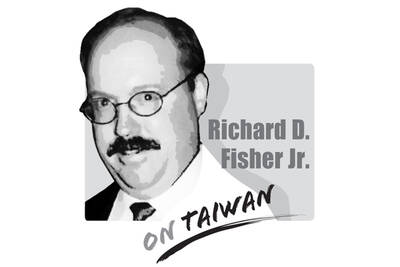Were it not for the need to maintain decorum and show Taiwan’s best face to the sporting world, the boycott by Chinese athletes of the World Games opening ceremony would warrant symbolic retaliation. No matter the reason for the boycott — refusing to recognize President Ma Ying-jeou (馬英九) at the ceremony, or just boycotting for boycotting’s sake — and no matter how predictable such Chinese behavior may be, the snub directed at a democratically elected leader and the country he represents was deeply offensive and violated the goodwill that underlies international sporting competition.
The irony, of course, is that the Ma government is relying on Chinese goodwill to enhance electoral credibility and thus is averse to retaliation of any nature. Indeed, hardliners in the Chinese Nationalist Party (KMT) legislative caucus rushed to hail the snub as a masterstroke of cross-strait detente. Were it not for Chinese goodwill, they bleat, the Chinese athletes would not be coming at all.
KMT Legislator Wu Yu-sheng (吳育昇), one such hardliner, on Thursday praised negotiations between Taiwan’s Olympic authority, the Chinese Taipei Olympic Committee, and Chinese authorities that allegedly resulted in the boycott deal. The only sensible response to this self-destructive conduct is that the Chinese Taipei Olympic Committee has, yet again, matched its incompetence in sports management with backroom mischief-making worthy of the International Olympic Committee itself.
None of this comes as any surprise. It is, however, becoming more and more interesting to reflect on what degree of insulting Chinese conduct Ma will tolerate personally given his typically pallid response to this snub — let alone behavior targeting the people he was elected to lead.
The World Games give China an opportunity to place itself in an attractive light in an international context, especially in light of the latest butchery in Xinjiang. These are, after all, world games, not an athletic exercise to exhort Chinese power and glory.
So, when the Taiwanese placard and flag carriers for the Chinese team walked out into the stadium with a large hole behind them where the Chinese delegation should have been, the insult was not just directed at Ma, or Taiwan, or the crowd that applauded politely and booed in roughly equal measure, but also at the other athletes.
For most, this incident will fade in the memory as the Games continue. For unificationists, it will probably lead to self-congratulation over the minimal backlash. For independence activists, however, the incident will add fuel to the theory that this nation’s president is prepared to subject himself to any act of symbolic denigration from the Chinese Communist Party in order to feed his obsession with Greater China and the economic and geopolitical confectionary it creates.
For credulous observers who would interpret Ma’s refusal, yet again, to take China’s bait as signs of statesmanship and strategic aplomb, the time will come when Ma’s effete and barren leadership will falter under direct acts of Chinese coercion, shattering their fantasies of regional stability and cooperation.
Ma’s presence at the World Games opening ceremony offered hope that he was becoming more willing to use his prestige as president in an international context. The Chinese boycott, however, reminds us that things have not changed very much.
As an instance of disposable cowardice, the reaction of the government and the KMT adds to a body of evidence that this president, this government and the party machine remain unwilling to rally around the flag at those symbolic moments that count.
On Sunday, 13 new urgent care centers (UCC) officially began operations across the six special municipalities. The purpose of the centers — which are open from 8am to midnight on Sundays and national holidays — is to reduce congestion in hospital emergency rooms, especially during the nine-day Lunar New Year holiday next year. It remains to be seen how effective these centers would be. For one, it is difficult for people to judge for themselves whether their condition warrants visiting a major hospital or a UCC — long-term public education and health promotions are necessary. Second, many emergency departments acknowledge

Victory in conflict requires mastery of two “balances”: First, the balance of power, and second, the balance of error, or making sure that you do not make the most mistakes, thus helping your enemy’s victory. The Chinese Communist Party (CCP) has made a decisive and potentially fatal error by making an enemy of the Jewish Nation, centered today in the State of Israel but historically one of the great civilizations extending back at least 3,000 years. Mind you, no Israeli leader has ever publicly declared that “China is our enemy,” but on October 28, 2025, self-described Chinese People’s Armed Police (PAP) propaganda
US President Donald Trump’s seemingly throwaway “Taiwan is Taiwan” statement has been appearing in headlines all over the media. Although it appears to have been made in passing, the comment nevertheless reveals something about Trump’s views and his understanding of Taiwan’s situation. In line with the Taiwan Relations Act, the US and Taiwan enjoy unofficial, but close economic, cultural and national defense ties. They lack official diplomatic relations, but maintain a partnership based on shared democratic values and strategic alignment. Excluding China, Taiwan maintains a level of diplomatic relations, official or otherwise, with many nations worldwide. It can be said that
Lockheed Martin on Tuesday responded to concerns over delayed shipments of F-16V Block 70 jets, saying it had added extra shifts on its production lines to accelerate progress. The Ministry of National Defense on Monday said that delivery of all 66 F-16V Block 70 jets — originally expected by the end of next year — would be pushed back due to production line relocations and global supply chain disruptions. Minister of National Defense Wellington Koo (顧立雄) said that Taiwan and the US are working to resolve the delays, adding that 50 of the aircraft are in production, with 10 scheduled for flight